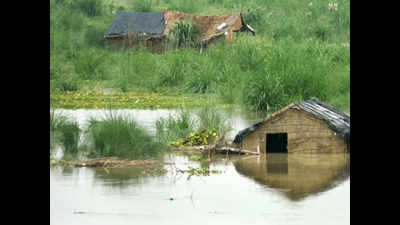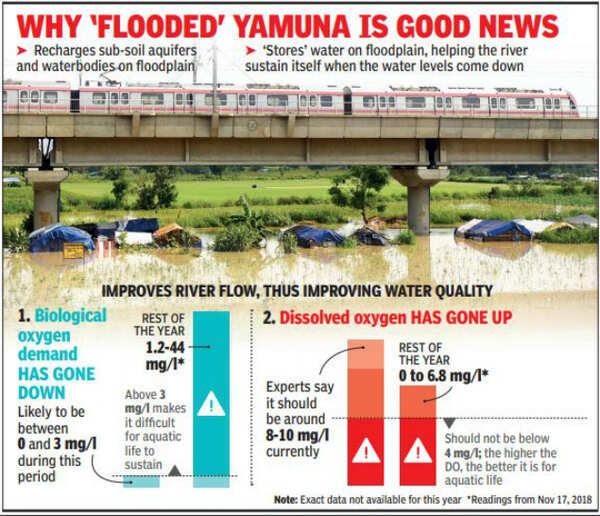- News
- City News
- delhi News
- Flood bad news for residents, but Yamuna high on cleanliness meter
Trending
This story is from August 25, 2019
Flood bad news for residents, but Yamuna high on cleanliness meter
Sudden rise in the water level of Yamuna wreaks havoc on people living in the floodplains almost every year

On Thursday, the river level fell below the ‘danger’ mark of 205.33 metres, and was flowing at 204.28 metres at 1 pm on Friday.
NEW DELHI: Sudden rise in the water level of Yamuna wreaks havoc on people living in the floodplains almost every year. Thousands get evacuated every time the water level soars to an alarming level. But flood is essential not just to keep the river alive through the year, but also to recharge the sub-soil aquifers along the floodplains, say experts.

With more water getting released through the Hathni Kund barrage — the Yamuna at present could be at its cleanest point this year.A significant improvement in the dissolved oxygen (DO) and biological oxygen demand (BOD) has been noticed over the past week.
Yamuna Jiye Abhiyan convener Manoj Mishra said that the river is thriving at present and serving an important ecological function. “During the floods, a lot of sub-soil aquifers get recharged, which helps the river sustain itself during the lean period. The water quality too has improved considerably, and the Yamuna should be at its cleanest point right now,” said Mishra.
Faiyaz Khudsar, scientist-in-charge at the Yamuna Biodiversity Park in north Delhi, said that the flooding has rejuvenated Phase-II of the biodiversity park, which falls in the active flood zone. “The DO should be around 8-10 mg/l, while the BOD appears to be around 3-4 mg/l, which is a great sign,” said Khudsar.
According to him, waterbodies and aquifers on the floodplains are receiving crucial water during this period. “When the river is flooded, the floodplains see a lot of plant species thrive as well. This then attracts more fauna, and helps sustain an entire ecosystem. Flooding phase plays a key role in improving the groundwater table too,” added Khudsar.
The University of Chicago’s Tata Centre for Development has been monitoring the water quality of the river for two years now through sensor-based technology that provides real-time readings. Priyank Hirani, programme director of the water-to-cloud project, said that tremendous improvements were observed each time water was released from the Hathni Kund barrage. “Water is being released now in huge quantities, which is sufficient to improve all parameters,” said Hirani.
On August 18, around 8.28 lakh cusecs was released by the barrage – the highest ever, and the river had touched 206.60 metres on Wednesday. On Thursday, the river level fell below the ‘danger’ mark of 205.33 metres, and was flowing at 204.28 metres at 1 pm on Friday.

With more water getting released through the Hathni Kund barrage — the Yamuna at present could be at its cleanest point this year.A significant improvement in the dissolved oxygen (DO) and biological oxygen demand (BOD) has been noticed over the past week.
Yamuna Jiye Abhiyan convener Manoj Mishra said that the river is thriving at present and serving an important ecological function. “During the floods, a lot of sub-soil aquifers get recharged, which helps the river sustain itself during the lean period. The water quality too has improved considerably, and the Yamuna should be at its cleanest point right now,” said Mishra.
“During the first spell of floods, water remains quite muddy. But after more water is released through the Hathni Kund barrage, the quality of water starts to improve. The flow of water allows the waterbody to have a higher dissolved oxygen count than what is normally seen through the year,” Mishra added.
Faiyaz Khudsar, scientist-in-charge at the Yamuna Biodiversity Park in north Delhi, said that the flooding has rejuvenated Phase-II of the biodiversity park, which falls in the active flood zone. “The DO should be around 8-10 mg/l, while the BOD appears to be around 3-4 mg/l, which is a great sign,” said Khudsar.
According to him, waterbodies and aquifers on the floodplains are receiving crucial water during this period. “When the river is flooded, the floodplains see a lot of plant species thrive as well. This then attracts more fauna, and helps sustain an entire ecosystem. Flooding phase plays a key role in improving the groundwater table too,” added Khudsar.
The University of Chicago’s Tata Centre for Development has been monitoring the water quality of the river for two years now through sensor-based technology that provides real-time readings. Priyank Hirani, programme director of the water-to-cloud project, said that tremendous improvements were observed each time water was released from the Hathni Kund barrage. “Water is being released now in huge quantities, which is sufficient to improve all parameters,” said Hirani.
On August 18, around 8.28 lakh cusecs was released by the barrage – the highest ever, and the river had touched 206.60 metres on Wednesday. On Thursday, the river level fell below the ‘danger’ mark of 205.33 metres, and was flowing at 204.28 metres at 1 pm on Friday.
End of Article
FOLLOW US ON SOCIAL MEDIA










